Catskills 1
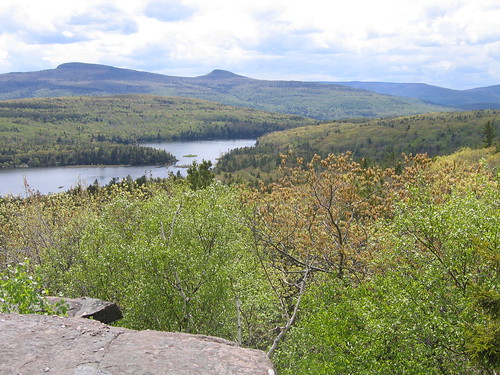
A famous vista, painted by Thomas Cole, one of the founders of the Hudson River School of landscape painting.
On our first field day, we spent the morning in the water, canoing on North-South Pond, the purpose of which was to see bog mats, but we stopped to look at everything.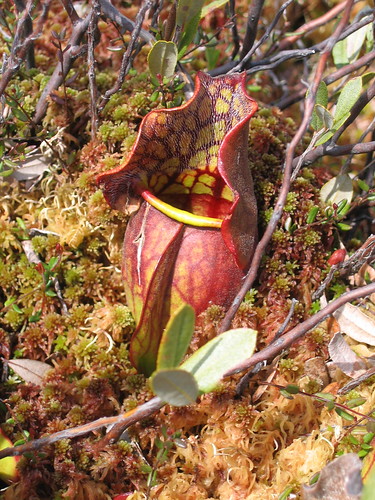
Pitcher plant (Sarracenia purpurea) leaf on a Sphagnum bog mat in North-South Pond. Note the hairs on the leaf, which lead the insect into the bowels of the leaf. There it is trapped, and eventually dissolved and thus "eaten" by the plant. This adaptation is very common in plants growing in low nutrient environments, like bogs. This plant is native to NYC & environs. 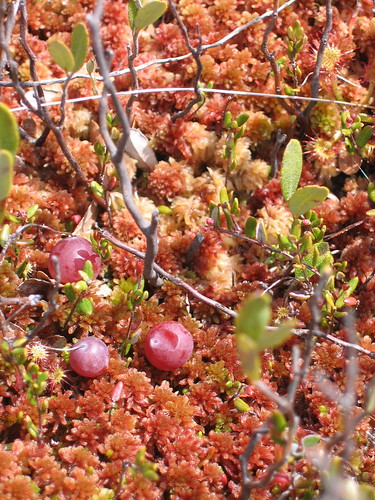
Large cranberry (Vaccinium macrocarpon) with last year's fruits on bog mat. Its leaves are long and oval, arranged on the arching stem of the diminuitive trailing shrub (center). Interspersed are some round-leaved sundew leaves (Drosera rotundifolia). Both of these are native plants.
After a wobbly (and wet) start, we managed to climb atop a stable portion of the largest bog mat. What fun to watch the unstable "ground" beneath you undulate with every step. The anchors of these systems appear to be the shrub, leatherleaf (Chamaedaphne calyculata var. angustifolia). At the same time, it's a little nerve-wracking, especially when your boots are only calf high.
Next up, climbing the escarpment trail. This was just as well, since I was itching to get out of the canoe. Being so limited makes it hard to botanize!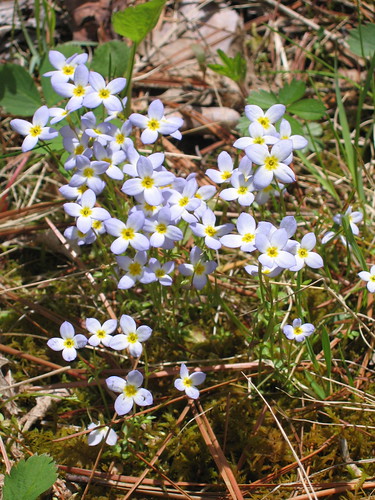
Bluets (Houstonia caerulea) are common along trails and mowed edges. A cute little native plant.
One of the most interesting observations was the elevated pine barrens - something I associated with coastal plains, but clearly, that was not the case here.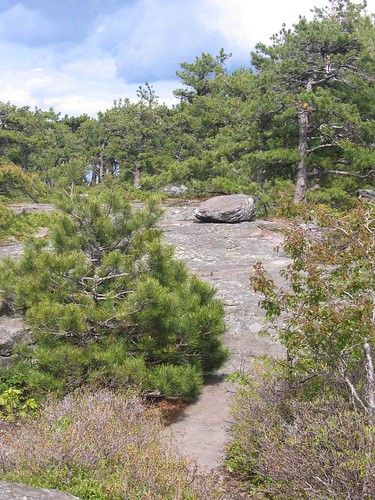
Pitch pine (Pinus rigida) and lowbush blueberry (Vaccinium angustifolium) dominate the landscape 3,500 feet above sea level.
One of the most marvelous things was the endless array of native plants. More species and more individuals in an endless, unbroken progression. It was breathtaking to think that this was even possible. It made me sad to think how much we have lost in New York City.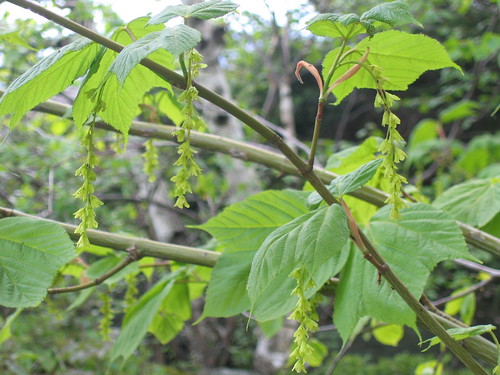
My new favorite tree, striped maple or moosewood (Acer pensylvanica) in flower. Sadly, this plant does not occur in NYC, but is native to other regions of the state.
Plants I jotted down (this is not a complete list)
Plant list 5/28
North/South Lake floating bogs
TREES
Gray birch (Betula populifolia)
Red spruce (Picea rubens) (very unusual, usually upland species)
SHRUBS
Allegheny serviceberry (Amelanchier laevis)
Leatherleaf (Chamaedaphne calyculata var. angustifolia)
Mountain holly (Nemopanthus mucronata)
Bristly dewberry (Rubus hispidus)
White meadowsweet (Spiraea alba var. latifolia)
Steeplebush (Spiraea tomentosa)
Large cranberry (Vaccinium macrocarpon) used for eating
Small cranberry (Vaccinium oxycoccos)
Withe-rod (Viburnum nudum var. cassinoides)
FORBS
Carolina fanwort (Cabomba caroliniana var. caroliniana)
Larger blueflag (Iris versicolor)
Northern pitcher-plant (Sarracenia purpurea)
Sweet white violet (Viola blanda)
Horned pondweed (Zannichellia palustris)
GRAMINOIDS
Blue joint grass (Calamagrostis canadensis)
Northwest Territory sedge (Carex utriculata)
Threeway sedge (Dulichium arundinaceum)
Common rush (Juncus effusus)
BRYOPHYTES
Sphagnum moss (Sphagnum spp.)
OTHER (LICHEN)
British soldiers – Cladonia sp.
Escarpment walk
TREES
Moosewood (Acer pensylvanicum)
Sugar maple (Acer saccharum)
Yellow birch (Betula allegheniensis)
White ash (Fraxinus americana)
Red pine (Pinus resinosa)
Pitch pine (P. rigida)
White pine (Pinus strobus)
Pin cherry (Prunus pensylvanica var. pensylvanica)
American basswood (Tilia americana)
Eastern hemlock (Tsuga canadensis)
SHRUBS
Running serviceberry (Amelanchier stolonifera) – tentative ID
Large leaf holly (Ilex montana)
Mountain laurel (Kalmia latifolia)
Fly honeysuckle (Lonicera canadensis)
Partridgeberry (Mitchella repens)
Early azalea (Rhododendron prinophyllum)
Prickly gooseberry (Ribes cynosbati)
Appalachian gooseberry (Ribes rotundifolium)
Red raspberry (Rubus idaeus)
Flowering raspberry (Rubus odoratus)
Red elderberry (Sambucus racemosa var. racemosa)
Early lowbush blueberry (Vaccinium angustifolium)
FORBS
Lyre-leaved rock cress (Arabis lyrata)
Wild sarsaparilla (Aralia nudicaulis)
Mountain aster (Aster acuminatus)(Oclemena acuminata)
Pink ladyslipper (Cypripedium acaule)
Wild strawberry (Fragaria virginiana)
Bluets (Houstonia caerulea)
Canada mayflower (Maianthemum canadensis)
Indian cukecumber root (Medeola virginiana)
Indian pipe (Monotropa uniflora)
Hairy Solomon’s seal (Polygonatum pubescens)
Early saxifrage (Saxifraga virginiensis var. virginiensis)
Heartleaf foamflower (Tiarella cordifolia var. cordifolia)
Starflower (Trientalis borealis)
Wake robin (Trillium erectum)
Painted trillium (Trillium undulatum)
Bird’s-eye speedwell (Veronica chamaedrys) *
Arrow-leaf violet (Viola sagittata)
FERNS
Bulblet bladderfern (Cystopteris bulbifera)
Rusty cliff fern (Woodsia ilvensis)
Rock polypody (Polypodium virginianum)
Bracken (Pteridium aquilinum)





1 comment:
Genial brief and this mail helped me alot in my college assignement. Say thank you you seeking your information.
Post a Comment